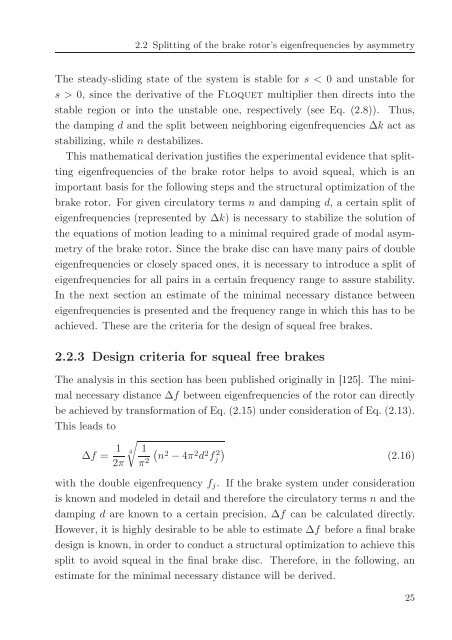Avoidance of brake squeal by a separation of the brake ... - tuprints
Avoidance of brake squeal by a separation of the brake ... - tuprints
Avoidance of brake squeal by a separation of the brake ... - tuprints
Create successful ePaper yourself
Turn your PDF publications into a flip-book with our unique Google optimized e-Paper software.
2.2 Splitting <strong>of</strong> <strong>the</strong> <strong>brake</strong> rotor’s eigenfrequencies <strong>by</strong> asymmetry<br />
The steady-sliding state <strong>of</strong> <strong>the</strong> system is stable for s < 0 and unstable for<br />
s > 0, since <strong>the</strong> derivative <strong>of</strong> <strong>the</strong> Floquet multiplier <strong>the</strong>n directs into <strong>the</strong><br />
stable region or into <strong>the</strong> unstable one, respectively (see Eq. (2.8)). Thus,<br />
<strong>the</strong> damping d and <strong>the</strong> split between neighboring eigenfrequencies ∆k act as<br />
stabilizing, while n destabilizes.<br />
This ma<strong>the</strong>matical derivation justifies <strong>the</strong> experimental evidence that splitting<br />
eigenfrequencies <strong>of</strong> <strong>the</strong> <strong>brake</strong> rotor helps to avoid <strong>squeal</strong>, which is an<br />
important basis for <strong>the</strong> following steps and <strong>the</strong> structural optimization <strong>of</strong> <strong>the</strong><br />
<strong>brake</strong> rotor. For given circulatory terms n and damping d, a certain split <strong>of</strong><br />
eigenfrequencies (represented <strong>by</strong> ∆k) is necessary to stabilize <strong>the</strong> solution <strong>of</strong><br />
<strong>the</strong> equations <strong>of</strong> motion leading to a minimal required grade <strong>of</strong> modal asymmetry<br />
<strong>of</strong> <strong>the</strong> <strong>brake</strong> rotor. Since <strong>the</strong> <strong>brake</strong> disc can have many pairs <strong>of</strong> double<br />
eigenfrequencies or closely spaced ones, it is necessary to introduce a split <strong>of</strong><br />
eigenfrequencies for all pairs in a certain frequency range to assure stability.<br />
In <strong>the</strong> next section an estimate <strong>of</strong> <strong>the</strong> minimal necessary distance between<br />
eigenfrequencies is presented and <strong>the</strong> frequency range in which this has to be<br />
achieved. These are <strong>the</strong> criteria for <strong>the</strong> design <strong>of</strong> <strong>squeal</strong> free <strong>brake</strong>s.<br />
2.2.3 Design criteria for <strong>squeal</strong> free <strong>brake</strong>s<br />
The analysis in this section has been published originally in [125]. The minimal<br />
necessary distance ∆f between eigenfrequencies <strong>of</strong> <strong>the</strong> rotor can directly<br />
be achieved <strong>by</strong> transformation <strong>of</strong> Eq. (2.15) under consideration <strong>of</strong> Eq. (2.13).<br />
This leads to<br />
∆f = 1 4<br />
2π<br />
√<br />
1 ( )<br />
n2<br />
π 2 −4π 2 d 2 fj<br />
2<br />
(2.16)<br />
with <strong>the</strong> double eigenfrequency f j . If <strong>the</strong> <strong>brake</strong> system under consideration<br />
is known and modeled in detail and <strong>the</strong>refore <strong>the</strong> circulatory terms n and <strong>the</strong><br />
damping d are known to a certain precision, ∆f can be calculated directly.<br />
However, it is highly desirable to be able to estimate ∆f before a final <strong>brake</strong><br />
design is known, in order to conduct a structural optimization to achieve this<br />
split to avoid <strong>squeal</strong> in <strong>the</strong> final <strong>brake</strong> disc. Therefore, in <strong>the</strong> following, an<br />
estimate for <strong>the</strong> minimal necessary distance will be derived.<br />
25

















